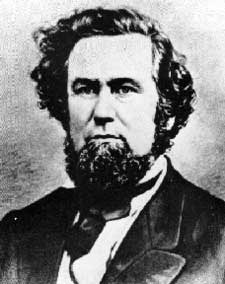
Governor of Virginia 1865-1868 This month the battle of Big Bethel is fought near Hampton. It is small, but the first engagement of note. Confederate troops repel a Union attack in this battle, and while it was an insignificant engagement, its value to the morale of the young Confederacy was out of proportion to its size. On June 8th the border states of Kentucky and Missouri were claimed by the Confederate government, though the Confederacy had no major presence in either state. Both later formed southern governments in exile once Union troops took over these states early in 1862. On June 11th pro-Union men met in Wheeling in western Virginia. The residents of these counties largely opposed secession. They felt isolated from the center of government in Richmond. They owned few slaves, and they had few commercial ties to the government in Richmond, dominated by large planters. Francis Pierpont became the first governor of Federal Virginia, later the state of West Virginia. In far off Sacramento, California, investors formed the Central Pacific Railroad, with the expressed intention of building a transcontinental railroad. No railroad or telegraph yet united the east and west coasts of the nation, and this grand undertaking took eight more years to see its completion. Across the Confederacy, mobilization continued as men joined local military companies, and these units merged together to form regiments.The wild enthusiasm for the war did not fade until the effects of major battles shook the confidence of the soldiers, and high prices and shortages began to affect civilians at home. The 18th Virginia, from the Southside region, suffered its first fatalities in June when privates Charles Gilchrist of Company H and John Reese of Company C died of disease, having never seen battle. They were the first of many Southside Virginia soldiers to illustrate the cold fact that more soldiers died of disease than battle in the Civil War. Charles had enlisted with his brother, another statistic that made Civil War casualties even more tragic: often friends, neighbors, and family members enlisted together. In front of the county courthouse in Appomattox, men of the Liberty Guards enlisted on the 19th. They later joined forces in western Virginia, and became Company A of the 46th Virginia Infantry Regiment. Dr. William Henry Abbitt captained the Guards. In Lynchburg, the Appomattox Rangers arrived to officially enter Confederate military service. They received assignments as Company H of the 2nd Virginia Cavalry Regiment. The hill city, at the junction of three railroad lines, became a training center for troops arriving from out of state. Soon 10,000 soldiers outnumber the town's 6,000 residents. At Richmond, the Appomattox Invincibles, who had enlisted in April, become Company A of the 44th Virginia Regiment. John Steptoe, a 25 year old member, wrote that, "while, of course, we do not say we will be invincible to any foe, still the name will have the effect of inspiring every man with a more ardent zeal not to disappoint expectations . . ." Susan Blackford of Lynchburg noted the continued preparations on the home front as the Masonic Hall was converted into a workshop. "Tailors came and cut out the uniforms, and the ladies brought their sewing machines. The work was divided out: some did the basting, others the pressing, some sewed and others made buttonholes, and it was marvelous to see the amount that was accomplished by the loving hands of those devoted women . . ." |
Last updated: March 31, 2012
